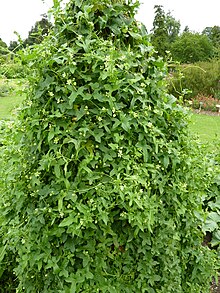Bryonia
| Bryonia | |
|---|---|
 |
|
| red bryony (B. dioica) | |
| Scientific classification | |
| Kingdom: | Plantae |
| (unranked): | Angiosperms |
| (unranked): | Eudicots |
| (unranked): | Rosids |
| Order: | Cucurbitales |
| Family: | Cucurbitaceae |
| Subfamily: | Cucurbitoideae |
| Tribe: | Benincaseae |
| Subtribe: | Benincasinae |
| Genus: |
Bryonia L. |
| Diversity | |
| 12 species | |
Bryonia is a genus of flowering plant in the gourd family. Bryony /ˈbraɪ.əni/ is its best-known common name. They are native to western Eurasia and adjacent regions, such as North Africa, the Canary Islands and South Asia.
Bryonies are perennial, tendril-climbing, diclinous or dioeciousherbs with palmately lobed leaves and flowers in axillary clusters. The fruit is a smooth, globular berry.
The only English species, B. dioica (white bryony), grows in hedgerows as far north as Yorkshire.
Bryonia is used as a food plant by the larvae of some Lepidoptera (butterflies and moths), including the tortrix moth Phtheochroa rugosana (recorded on red bryony, B. dioica) and the Cabbage Moth (Mamestra brassicae).
...
Wikipedia
